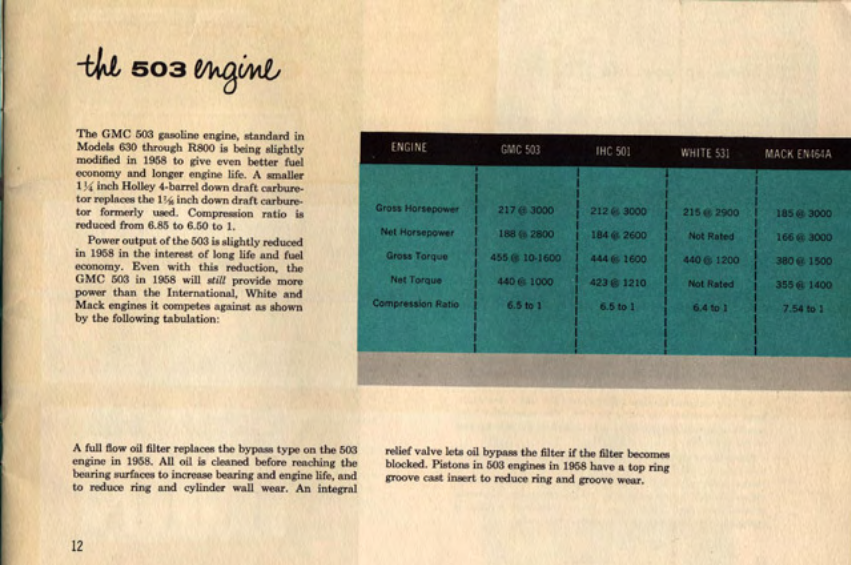
Geoff Weeks
Pedigreed Bulldog-
Posts
2,120 -
Joined
-
Last visited
-
Days Won
7
Content Type
Profiles
Forums
Gallery
Events
Blogs
BMT Wiki
Collections
Store
Everything posted by Geoff Weeks
-
1972 Loadstar , my love for loadstars continues .
Geoff Weeks replied to 85snowdog's topic in Other Truck Makes
I was leased to two smaller trucking companies that were both started in the '30's and both were in bad shape by 2000, they were great people to work with/for. The internet killed them more than de-reg, or the internet was the final nail after de-reg weakened them. Not sure which way but they were both doing well enough in the 90's when I was with them. -
1972 Loadstar , my love for loadstars continues .
Geoff Weeks replied to 85snowdog's topic in Other Truck Makes
I think the "center cab" trucks were a short term solution to a problem solved in another way. They seamed to be around in the 60's and 70's and mostly gone by the 80's. They could get into old cramped mfg districts with load that a semi could not. Those districts were likely service by spur rail line in older times. (can you imagine trying to get the rail-road to deliver a few I beams?) With more stuff moved by truck, if you couldn't get a std semi in you either moved or remodeled so you could, making the center cab an obsolete item. They also had almost zero value on the secondary market. You can't really re-use them for something else. Urban renewal, flight to the suburbs and beyond for cheap industrial land ended the need for them. I don't think I've seen a truck later than the Loadstar made into a center cab unless it was that purpose built truck I saw on I-79 all those years ago. It was so unrecognizable as to who made the chassie, might have been CCC (Crane carrier corp), so hard to date it. -
1972 Loadstar , my love for loadstars continues .
Geoff Weeks replied to 85snowdog's topic in Other Truck Makes
From what I remember also the windshield was two piece gasketed so you could push one out and get out if the top and sides were blocked for some reason. Hauling crane beams on take-a-part trailers where the beam itself provides all the structure, makes you painfully aware about chaining down loads. Bridge girders are the same. Old "fish belly" girders were nerve wracking as you had to crib them up so high to clear. -
1972 Loadstar , my love for loadstars continues .
Geoff Weeks replied to 85snowdog's topic in Other Truck Makes
Yeah, that is how I remember them, but it might also have been an earlier "R" series which had low flat fenders. -
1972 Loadstar , my love for loadstars continues .
Geoff Weeks replied to 85snowdog's topic in Other Truck Makes
I don't think a driver had much input on those Loadstars. I have also seen one, that looked like a "carry-deck crane" without the crane part. Tiny drivers cab offset all the way to the left. and flat deck from the rear to the front. I saw it driving down I 79 south of Erie, Pa. I don't think a driver would much care for entering and exiting through the (leaky?) roof hatch. -
1972 Loadstar , my love for loadstars continues .
Geoff Weeks replied to 85snowdog's topic in Other Truck Makes
yes, I've seen quite a few of them. -
1972 Loadstar , my love for loadstars continues .
Geoff Weeks replied to 85snowdog's topic in Other Truck Makes
From what I can find the V6 GMC came out "new" for model year 1960, so production in 1959, so one would guess the 503 was done in the '59 model year. -
1972 Loadstar , my love for loadstars continues .
Geoff Weeks replied to 85snowdog's topic in Other Truck Makes
interesting comparison. They list the RD501 at 3000 but it was gov at 2600 so not sure that was a one time test! -
If I had to guess I would say the three are supply, line to brakes and exhaust line to outside the cab. here in the states, the same supply to the trailer supply button is also used for parking brake release Multi fuction valves get a supply from both the primary and secondary air system. But I have no idea how it is done in other parts of the world.
-
1972 Loadstar , my love for loadstars continues .
Geoff Weeks replied to 85snowdog's topic in Other Truck Makes
450 was the biggest dry lined IHC 6 the 501 was parent bore. IDK when the GMC 503 stopped being made in favor of the big V6 that came later. My parts truck came with a RD450 that was replaced with a re-newed (IHC's factory rebuild program) 406, long before I had it. Always wondered what it was like to run one of the big inline gassers. -
1972 Loadstar , my love for loadstars continues .
Geoff Weeks replied to 85snowdog's topic in Other Truck Makes
LaPort Transport ran an all gas fleet of IHC and Ford until they closed sometime in the late 90's early 2000's. Before my time but do you know how the GMC 503 and the IHC 450-501 inlines stacked up against the diesels? I had a 406 in a parts truck for awhile. sold the engine for more than I paid for the whole truck. -
Ahh, well I don't have a clue on how it is done over there. The British buses used a mechanical hand brake and the Austrian were similar to the US in having a button that pops out on loss of pressure.
-
The guy that made the post I read I believe was from Kansas. Likely more a rural thing.
-
What type of valving does the truck have, a multi function valve with both red and yellow knobs or individual buttons ?
-
Do both air tanks (primary and secondary) have pressure?
-
Air compressor question e7
Geoff Weeks replied to mcratchet1's topic in Modern Mack Truck General Discussion
If you are working somewhere with its own compressed air supply (shop air), you can remove the safety valve on the compressor head and put an air fitting to connect to shop air, to look for leaks without the engine running. If you are working on one that doesn't have a safety at the compressor, you can either cobble together some fittings to supply air there or most air driers have a relief that you can remove and install a fitting for diagnosing purposes. -
1972 Loadstar , my love for loadstars continues .
Geoff Weeks replied to 85snowdog's topic in Other Truck Makes
IHC had different compression pistons both for altitude and for "export". One being higher the other lower. All IHC designed engines were truck engines (or ag) from the get go. Made them stout as opposed to converted passenger car designs. -
I was on some site, Might have been here or might have been JOT where one recounted how STUDENTS drove the school buses in their area. It was a big plum of a job with many applying and few getting. Lots of training and one mishap, however minor meant you were gone! Imagine that today!
-
Our school buses chained up and kept going. I can still "hear" the sound of the 392 and the tire chains. And that was if lived far enough out not to walk (up hill both ways in a snow storm). They did call off school before the chains were needed on the steer tires tho, softies!
-
Air compressor question e7
Geoff Weeks replied to mcratchet1's topic in Modern Mack Truck General Discussion
Water, unless it has antifreeze mixed in is not from a mechanical defect in the compressor. Oil can pass and get excessive on a well worn compressor, BUT it can also come from too much on time. Look at it this way: your system cycles 23 times more than mine, meaning that 23 time more air, condensate and oil are put into the system then mine does. even my worse truck passes 10 times less than yours is. On mine, the small amount of oil gets separated at the labyrinth passages in the AD-4 base, the moisture gets stripped in the drier bed, both get expelled when the drier purges. Even with an air starter, air wipers, air ride, I never saw any moisture in the wet tank, the air use was such that the air drier could do its job. With yours passing so much air, you are likely going to need to service the air drier when your problem is solved, but no point doing so until the air leaks are addressed. I had a problem with the AD-9's where the drier cartridge would back out of the base and just be rattling around inside the dome. They used a single threaded bolt on the bottom of the cartridge into the aluminum base, heat and vibration would cause them to loosen. enough time on them, the thread in the base would wear and not stay tight. AD-4's have some draw backs but that isn't among them, I switched to them. Spin on filter air driers don't have there internal purge air and must take it from somewhere. -
Air compressor question e7
Geoff Weeks replied to mcratchet1's topic in Modern Mack Truck General Discussion
water and oil is more a sign of excessive "on time". Knocking, like piston slap or con rod bearing is a sign of a worn out compressor that is on its way out. You can read what Bendix say in the attached .pdf TF 501.pdf -
electronic speedos came out around 1983 +/-. However my 1992 Marmon came with a cable driven speedo, but fairly sure it was one of the last. When electronic engines and ECM's came around in the early 90's, and then the speedo's became operated on the Can Bus from the ECM. The early electronics had 3, 4 or 5 wires. power + and -, signal and signal ground (two grounds are combined on 3 wire speedos) and then they often have a extra wire for 2 spd axle correction. Most common are 4 wire, + and - and then two wires to the pick-up. Tach is the same but of course no 2 spd axle wire.
-
"Send us your trash (bags)"!
BigMackTrucks.com
BigMackTrucks.com is a support forum for antique, classic and modern Mack Trucks! The forum is owned and maintained by Watt's Truck Center, Inc. an independent, full service Mack dealer. The forums are not affiliated with Mack Trucks, Inc.
Our Vendors and Advertisers
Thank you for your support!





